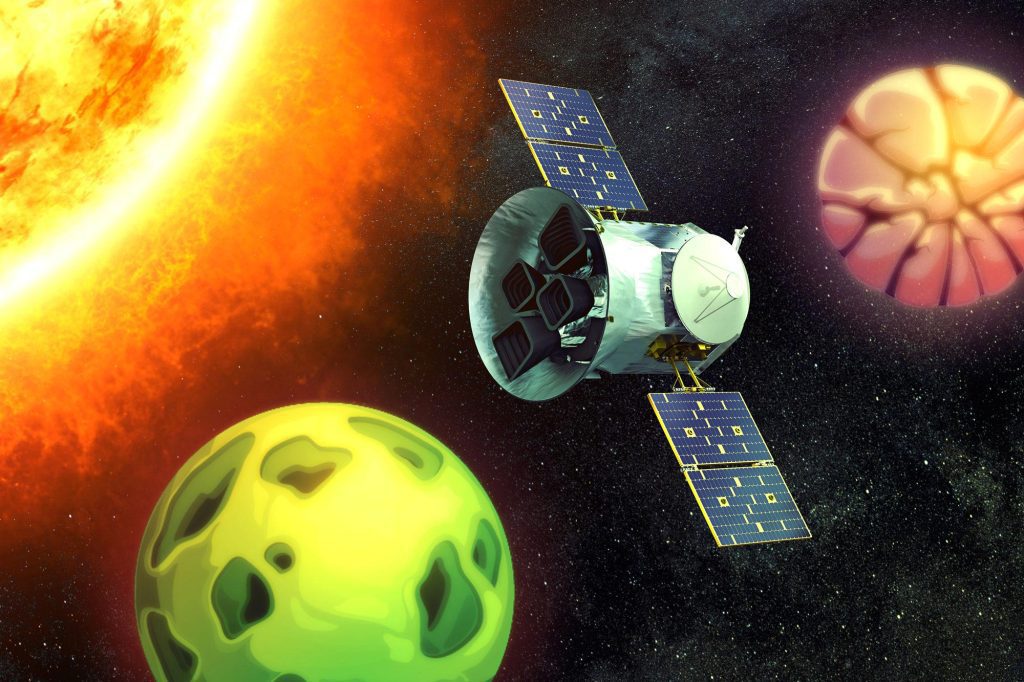
Астрономы Массачусетского технологического института обнаружили новую многопланетную систему, расположенную на расстоянии 10 парсеков, или около 33 световых лет, от Земли, что делает ее одной из самых близких известных многопланетных систем к нашей системе. Звезда в ядре системы, вероятно, содержит как минимум две планеты земного типа размером с Землю. Предоставлено: MIT News, персонаж спутника TESS предоставлен НАСА.
Расположенная всего в 33 световых годах от Земли, эта система, похоже, содержит две скалистые планеты размером с Землю.
Новая многопланетная система была обнаружена в соседней галактике астрономами в[{» attribute=»»>MIT and elsewhere. It lies just 10 parsecs, or about 33 light-years, from Earth, making it one of the closest known multiplanet systems to our own.
At the heart of the system lies a small and cool M-dwarf star, named HD 260655, and astronomers have found that it hosts at least two terrestrial, Earth-sized planets. The rocky worlds have relatively tight orbits, exposing the planets to temperatures that are too high to sustain liquid surface water. Therefore, they are unlikely to be habitable.
Nevertheless, scientists are excited about this system because the proximity and brightness of its star will give them a closer look at the properties of the planets and signs of any atmosphere they might hold.
“Both planets in this system are each considered among the best targets for atmospheric study because of the brightness of their star,” says Michelle Kunimoto, a postdoc in MIT’s Kavli Institute for Astrophysics and Space Research and one of the discovery’s lead scientists. “Is there a volatile-rich atmosphere around these planets? And are there signs of water or carbon-based species? These planets are fantastic test beds for those explorations.”
The team will present its discovery on June 15, 2022, at the meeting of the American Astronomical Society in Pasadena, California. Team members at MIT include Katharine Hesse, George Ricker, Sara Seager, Avi Shporer, Roland Vanderspek, and Joel Villaseñor, along with collaborators from institutions around the world.

Illustration of NASA’s Transiting Exoplanet Survey Satellite (TESS) at work. Credit: NASA’s Goddard Space Flight Center
Data power
The new planetary system was initially identified by NASA’s Transiting Exoplanet Survey Satellite (TESS), an MIT-led mission that is designed to observe the nearest and brightest stars, and detect periodic dips in light that could signal a passing planet.
In October 2021, Kunimoto, a member of MIT’s TESS science team, was monitoring the satellite’s incoming data when she noticed a pair of periodic dips in starlight, or transits, from the star HD 260655.
She ran the detections through the mission’s science inspection pipeline, and the signals were soon classified as two TESS Objects of Interest, or TOIs — objects that are flagged as potential planets. The same signals were also found independently by the Science Processing Operations Center (SPOC), the official TESS planet search pipeline based at NASA Ames. Scientists typically plan to follow up with other telescopes to confirm that the objects are indeed planets.
The process of classifying and subsequently confirming new planets can often take several years. For HD 260655, that process was shortened significantly with the help of archival data.
Soon after Kunimoto identified the two potential planets around HD 260655, Shporer looked to see whether the star was observed previously by other telescopes. As luck would have it, HD 260655 was listed in a survey of stars taken by the High Resolution Echelle Spectrometer (HIRES), an instrument that operates as part of the Keck Observatory in Hawaii. HIRES had been monitoring the star, along with a host of other stars, since 1998, and the researchers were able to access the survey’s publicly available data.
HD 260655 was also listed as part of another independent survey by CARMENES, an instrument that operates as part of the Calar Alto Observatory in Spain. As these data were private, the team reached out to members of both HIRES and CARMENES with the goal of combining their data power.
“These negotiations are sometimes quite delicate,” Shporer notes. “Luckily, the teams agreed to work together. This human interaction is almost as important in getting the data [as the actual observations]. «
планетарная тяга
В конце концов, эти совместные усилия быстро подтвердили наличие двух планет вокруг HD 260655 примерно за шесть месяцев.
Чтобы подтвердить, что сигналы от TESS действительно исходили от двух вращающихся планет, исследователи изучили данные как HIRES, так и CARMENES звезды. Оба обзора измеряют гравитационные колебания звезды, также известные как ее лучевая скорость.
«Каждая планета, вращающаяся вокруг звезды, будет иметь небольшую гравитационную силу на своей звезде», — объясняет Кунимото. «То, что мы ищем, — это любое незначительное движение этой звезды, которое может указывать на то, что объект планетарной массы притягивает ее».
Из обоих наборов архивных данных исследователи обнаружили статистически значимые сигналы о том, что сигналы, обнаруженные TESS, действительно были двумя вращающимися вокруг планетами.
«Тогда мы знали, что у нас есть что-то очень захватывающее», — говорит Спорер.
Затем команда внимательно изучила данные TESS, чтобы определить характеристики обеих планет, включая период их обращения и размер. Они определили, что внутренняя планета, получившая прозвище HD 260655b, обращается вокруг звезды каждые 2,8 дня и примерно в 1,2 раза больше Земли. Вторая экзопланета, HD 260655c, вращается каждые 5,7 дня и в 1,5 раза массивнее Земли.
Из данных о лучевой скорости от HIRES и CARMENES исследователи смогли рассчитать массу планет, которая напрямую связана с амплитудой, с которой каждая планета тащит свою звезду. Они обнаружили, что внутренняя планета имеет массу, в два раза превышающую массу Земли, а внешняя планета имеет массу примерно в три массы Земли. По размеру и массе команда оценила плотность каждой планеты. Меньшая внутренняя планета немного более плотная, чем Земля, а большая внешняя планета немного менее плотная. Вполне вероятно, что обе планеты, в зависимости от их плотности, имеют земной или каменистый состав.
Исследователи также оценивают, основываясь на их коротких орбитах, что внутренняя поверхность планеты имеет температуру 710 К (818 градусов).[{» attribute=»»>Fahrenheit), while the outer planet is around 560 °K (548 °F).
“We consider that range outside the habitable zone, too hot for liquid water to exist on the surface,” Kunimoto says.
“But there might be more planets in the system,” Shporer adds. “There are many multiplanet systems hosting five or six planets, especially around small stars like this one. Hopefully, we will find more, and one might be in the habitable zone. That’s optimistic thinking.”
This research was supported, in part, by NASA, the Max-Planck-Gesellschaft, the Consejo Superior de Investigaciones Científicas, the Ministerio de Economía y Competitividad, and the European Regional Development Fund.

«Наркоман поп-культуры. Поклонник телевидения. Ниндзя алкоголика. Абсолютный фанат пива. Профессиональный знаток твиттера».







More Stories
SpaceX успешно запустила группировку навигационных спутников для Евросоюза
Замечена пара массивных плазменных струй, вылетающих из гигантской черной дыры Черные дыры
Драматические изображения гигантской полнолуния и частичного лунного затмения